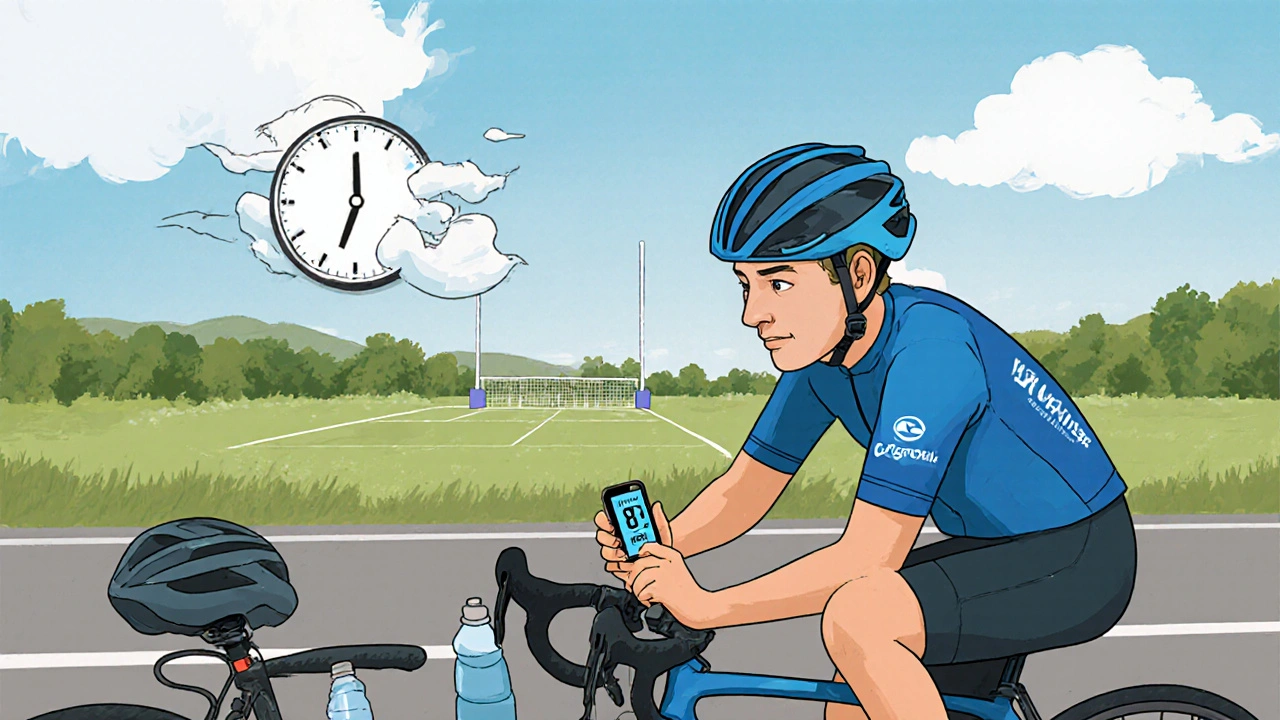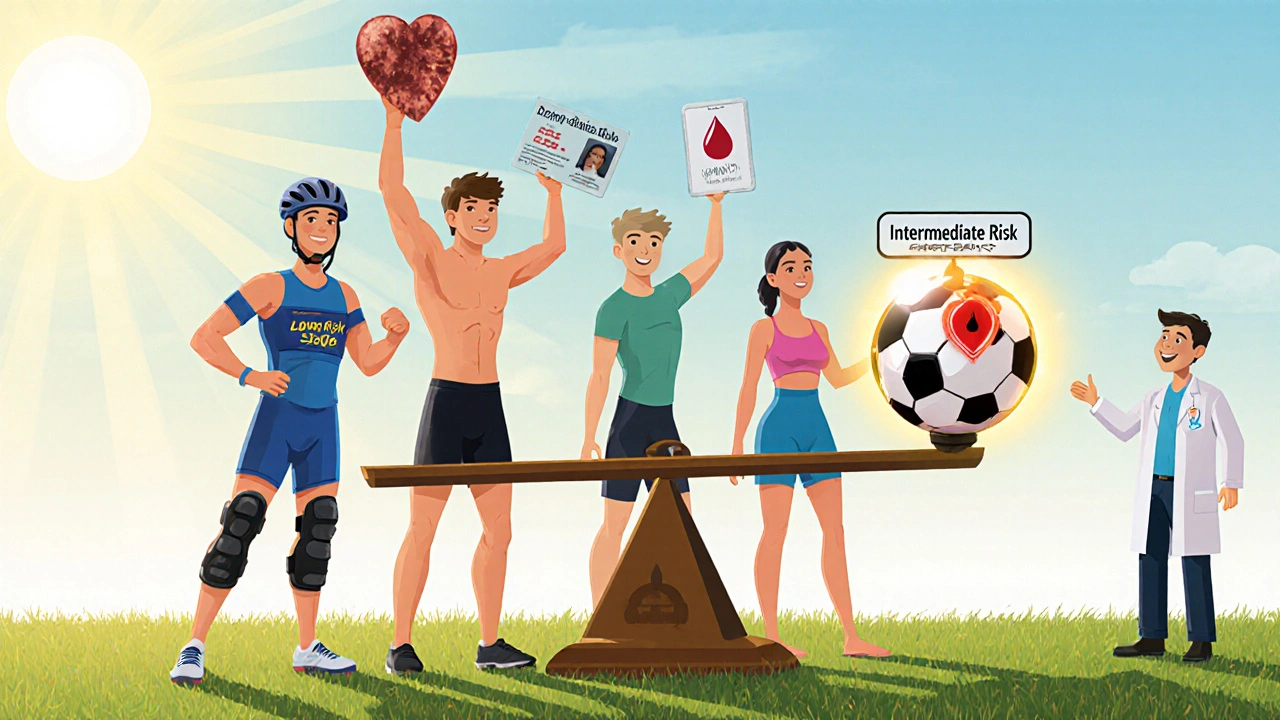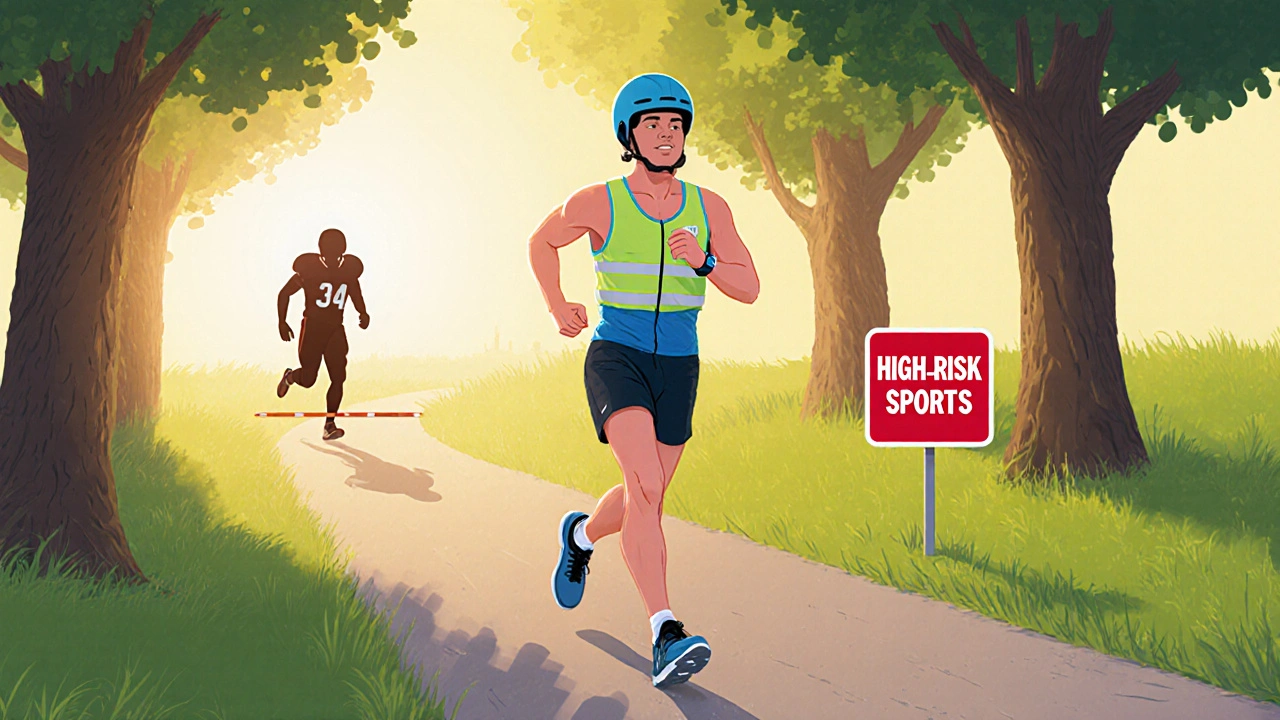Playing sports while on blood thinners isn’t just risky-it’s a tightrope walk between staying active and avoiding life-threatening bleeding. If you’re an athlete on anticoagulants, you’re not alone. More runners, cyclists, and even weekend warriors are managing conditions like atrial fibrillation or deep vein thrombosis while trying to keep training. But here’s the hard truth: anticoagulants turn a simple fall into a medical emergency. A collision that might give a non-medicated person a bruise could send someone on warfarin or apixaban to the ER with internal bleeding.
Why Sports and Blood Thinners Don’t Mix Easily
Anticoagulants stop clots from forming. That’s good for your heart. But when you’re playing soccer, skiing, or even getting tackled in a pickup basketball game, your body needs to clot to stop bleeding. When that system is suppressed, even minor trauma can cause serious internal bleeding-especially in the brain, muscles, or abdomen. Studies show athletes on anticoagulants are 3 to 5 times more likely to suffer major bleeding than non-athletes. In high-impact sports like rugby or ice hockey, that risk jumps to over 20% during competition. That’s not a small number. It’s a career-ending or life-threatening chance.Not All Sports Are Created Equal
The good news? Not every sport is off-limits. Experts classify activities into three risk levels based on how often trauma happens:- High-risk sports (avoid entirely): Football, rugby, boxing, ice hockey, wrestling. These involve collisions with forces over 5G. Even padded gear won’t stop internal bleeding when your blood can’t clot properly.
- Intermediate-risk sports (proceed with caution): Basketball, soccer, alpine skiing, lacrosse. About 30-60% of athletes in these sports experience trauma during play. You might be able to continue, but only with strict medical oversight and protective gear.
- Low-risk sports (generally safe): Running, cycling, swimming, rowing, yoga. Trauma risk is under 10%. With proper precautions, many athletes stay active here without increased bleeding.
A 2018 study found that athletes in low-impact sports had only a 1.3% chance of major bleeding. In high-impact sports? It was 22.7%. That’s a 17-fold difference. Your sport choice isn’t just about fitness-it’s about survival.
Warfarin vs. DOACs: Which Is Safer for Athletes?
There are two main types of blood thinners: warfarin and direct oral anticoagulants (DOACs). They work differently, and that changes everything for athletes.Warfarin has been around for decades. It’s cheap. But it’s unpredictable. Your INR (a blood test that measures clotting time) can swing wildly based on what you eat, what meds you take, or even how much you sleep. You need weekly blood tests. And if you’re about to play a game? You can’t just skip a dose. Warfarin sticks around for days. That means you’re always at risk.
DOACs like apixaban, rivaroxaban, and dabigatran are newer. They’re more consistent. No weekly blood tests. Fewer food interactions. And here’s the big advantage: they leave your system fast. Apixaban clears in 8-15 hours. Dabigatran in 12-17. That opens up a strategy warfarin can’t match: timing your dose around competition.
For example, a professional cyclist on apixaban might take their dose at 8 a.m. on the day before a race. By race day, levels drop to subtherapeutic-enough to prevent clots from forming during travel or rest, but not enough to cause dangerous bleeding if they crash. Studies show this approach cuts bleeding risk by 37% without increasing clot risk. That’s not magic. It’s science.
But there’s a catch. DOACs aren’t for everyone. If you have a mechanical heart valve, DOACs are banned. Warfarin is still the only option. And even with DOACs, you’re not invincible. A hard fall on the slopes or a bad tackle can still cause bleeding.

Four Proven Strategies to Stay Active Safely
Athletes on anticoagulants aren’t stuck on the sidelines. Four strategies have been tested and proven in real-world cases:- Switch to low-impact sports: Runners and swimmers who use helmets, pads, and avoid crowded trails reduce bleeding risk from 8.2% to just 1.9%. Simple changes matter.
- Temporarily lower warfarin: Some doctors reduce warfarin 3-4 days before a competition to bring INR down to 1.5-1.8. This lowers bleeding risk but raises clot risk slightly-0.8% per event versus 0.2% on full dose. Only do this under strict supervision.
- Use LMWH with timed breaks: Enoxaparin (a shot you give yourself daily) can be stopped 24 hours before a game. It clears quickly and keeps clot protection high. This cuts bleeding risk by 42% and is used by many elite athletes.
- Personalize DOAC timing: Based on your body’s metabolism, your doctor can test your drug levels and schedule your dose so it’s lowest during competition. One cyclist did this with apixaban-taking it 24 hours before races-and competed safely for years. This requires special blood tests (anti-Xa assays) and isn’t available everywhere.
These aren’t theoretical. They’re used by NBA players, UCI cyclists, and marathoners across Europe and North America. The key? No one-size-fits-all. Your plan must be tailored.
What the Experts Say
Dr. Paul D. Thompson, who helped write the American Heart Association’s guidelines, puts it bluntly: “You have to weigh the risk of a clot against the risk of a bleed. For endurance athletes, dehydration and inflammation raise clot risk. But a tackle in soccer? That’s a bleeding emergency.”Dr. Matteo Palamà, who led a major 2023 review, says DOACs are now the first choice for athletes-not because they’re safer overall, but because they can be timed. “You can’t pause warfarin. You can pause apixaban. That changes everything.”
But there’s a gap. Only 0.3% of patients in major anticoagulant trials were athletes. That means most guidelines are based on office workers, not sprinters. Experts admit: we’re guessing in places. That’s why personalized testing is becoming essential.

What’s Changing Right Now
Technology is catching up. In March 2023, the FDA cleared the CoaguChek INRange device for home INR testing. Athletes can now check their clotting levels in minutes, without driving to a lab. That’s huge for people training early in the morning or traveling for competitions.Wearable sensors are also being tested. Researchers are attaching accelerometers to athletes in 12 sports to measure exactly how hard they hit the ground, the wall, or another player. This data will help build new rules: “If you play rugby and your impact exceeds 6G, you can’t be on anticoagulants.” That’s the future.
Professional leagues are adapting too. The NBA requires INR under 2.0 for players on warfarin. The UCI (cycling’s governing body) allows DOACs if the dose is skipped 24 hours before competition. And the World Anti-Doping Agency confirmed: anticoagulants aren’t performance-enhancing drugs. You just need paperwork.
What You Need to Do Right Now
If you’re on blood thinners and want to play sports:- Don’t assume you can’t play. Many can-just not in high-risk sports.
- Get a formal risk assessment. Use tools like CHA₂DS₂-VASc for atrial fibrillation or HERDOO2 for clot recurrence risk.
- Ask your doctor about switching from warfarin to a DOAC if you’re eligible.
- Find out if your sport is high, medium, or low risk. Don’t guess.
- Never skip your meds without medical advice-even if you’re “just going for a jog.”
- Wear protective gear. Helmets, pads, and even padded clothing can reduce impact.
- Keep a copy of your anticoagulant regimen in your wallet or phone. Emergency responders need to know.
There’s no perfect solution. But there are smart ones. With the right plan, you don’t have to give up sports. You just have to be smarter about them.
Can I still run if I’m on blood thinners?
Yes, running is considered a low-risk sport with less than 10% chance of trauma. Many athletes on anticoagulants continue running safely, especially if they avoid crowded trails, wear reflective gear, and stay hydrated. Studies show major bleeding risk drops from 8.2% to 1.9% when runners use protective habits. Always check your INR or DOAC levels before long runs, and avoid running in icy or uneven conditions.
Is it safe to play basketball on anticoagulants?
Basketball is classified as an intermediate-risk sport with a 30-60% chance of collision. Most experts advise against it, especially competitively. However, some athletes play recreational basketball with full protective gear-knee pads, elbow pads, and a mouthguard-and under close medical supervision. Your doctor may recommend switching to a DOAC and timing your dose so levels are lowest during play. But the risk remains. Many cardiologists will still say no.
Can I stop taking my blood thinner before a game?
Only under direct medical supervision. Stopping warfarin is dangerous-it takes days to clear and increases clot risk. DOACs like apixaban or rivaroxaban can be paused 24 hours before competition because they leave your system faster. This is a proven strategy used by elite athletes. But never do this on your own. Skipping doses without a plan can trigger a stroke or pulmonary embolism. Always coordinate with your cardiologist and get a blood test if possible.
Which blood thinner is best for athletes?
For most athletes without mechanical heart valves, apixaban is the preferred choice. A 2025 study of over 160,000 patients found apixaban had the lowest risk of both recurrent clots and major bleeding compared to rivaroxaban and warfarin. Its short half-life (8-15 hours) allows for safe timing around events. Dabigatran is also an option, but it requires twice-daily dosing, which complicates scheduling. Warfarin is only used when DOACs aren’t allowed, like with mechanical valves.
Do I need to tell my coach or teammates I’m on blood thinners?
Yes. At minimum, your coach, trainer, or team captain should know. If you collapse or get injured, they need to know you’re on anticoagulants so they don’t apply pressure to stop bleeding or give you NSAIDs like ibuprofen, which can increase bleeding risk. Carry a medical ID card or wear a bracelet. In an emergency, seconds matter.
Are there new devices that help athletes on blood thinners?
Yes. The CoaguChek INRange device, cleared by the FDA in March 2023, lets you test your INR at home with a finger prick. Results are accurate within 0.2 INR units. For DOAC users, specialized anti-Xa blood tests can measure drug levels and help time doses around events. Wearable sensors that measure impact force during sports are being tested in research labs and may soon guide official safety rules.


10 Comments
Brittney Lopez
Just wanted to say how much I appreciate this post-it’s so rare to see real talk about sports and anticoagulants without sounding like a medical textbook. I’m a runner on apixaban, and honestly, I used to feel so alone until I found this community. I wear a helmet on every ride, avoid icy trails, and always carry my med card. Small things, but they make all the difference. You’re not broken-you’re just playing a different game now, and that’s okay.
Adarsha Foundation
This is beautifully written. I’m from India and have a cousin on warfarin who used to play kabaddi-now he does yoga and swimming. He says he feels more alive than before, even if he can’t tackle anymore. It’s not about giving up-it’s about choosing wisely. Thank you for validating that.
Alex Sherman
Look, I get it. You want to keep running. But let’s be real-this isn’t ‘empowerment.’ It’s playing Russian roulette with your brain. You think a helmet’s going to stop a subdural hemorrhage when your blood’s thinned out? That’s not courage-it’s denial wrapped in a Lululemon onesie. The data says you’re 17x more likely to bleed out. Stop pretending you’re a superhero.
Oliver Myers
I just wanted to say how incredibly thoughtful and well-researched this post is-thank you so much! It’s so easy to feel isolated when you’re managing a chronic condition while trying to stay active, but this gives real, actionable hope. I’ve been on apixaban for two years now, and I switched from basketball to cycling last spring. I time my dose at 8 p.m. the night before a long ride, and I’ve never had a single issue. It’s not perfect, but it’s possible-and you’re not alone.
John Concepcion
Wow, so you’re telling me I can just skip my meds before a game and be fine? Like, what, I’m supposed to be some kind of elite athlete to get away with this? My buddy took his apixaban 24 hours before his weekend soccer game and ended up in the ER with a spleen bleed. You’re not a genius, you’re just lucky. And now you’re giving people false hope? That’s not science-that’s a TikTok trend.
Caitlin Stewart
I’ve coached high school swimmers for 12 years, and two of them were on DOACs. One had a clot after a long flight, the other had AFib from overtraining. Both switched to low-impact sports, wore compression gear, and never missed a season. It’s not about the sport-it’s about the mindset. You don’t have to be the fastest. You just have to be smart. And you’re not weak for choosing safety.
Emmalee Amthor
Okay but what if you’re not an athlete? What if you’re just a 45-year-old mom who walks 5 miles a day and doesn’t want to feel like a patient? I’ve been on rivaroxaban for 3 years, I don’t wear a helmet, I don’t test my levels, and I’ve never bled out. Maybe the real problem isn’t the sport-it’s the fear they sell us. I’m not going to live in a bubble because some doctor said ‘high risk.’ Life’s risky. So what?
Leslie Schnack
Interesting. I’m curious-how many of these athletes actually got clearance from their cardiologist before competing? Or are we just hearing from the ones who didn’t and got lucky? Also, do we have data on how many people had strokes because they skipped their DOAC to play basketball? I’d love to see the actual numbers behind the ‘timing’ strategy. Not just the success stories.
Saumyata Tiwari
How can you even compare Western sports to traditional Indian athletics? In India, we have Kho-Kho and Mallakhamb-no collisions, pure discipline. You people treat your bodies like machines that can be ‘optimized’ with drugs and timing. We don’t need fancy devices. We need respect for the body’s natural limits. This whole post feels like American arrogance wrapped in medical jargon.
Anthony Tong
Let’s be honest: this entire ‘timing DOACs’ strategy is a corporate ploy. The pharmaceutical companies pushed DOACs because they’re more profitable than warfarin. Now they’re marketing them as ‘athlete-friendly’ to increase sales. The FDA cleared CoaguChek INRange? That’s a device made by Roche. And suddenly, elite athletes are ‘safely’ skipping doses? Please. This is a controlled narrative. The real danger isn’t the fall-it’s the profit motive behind the ‘solution.’